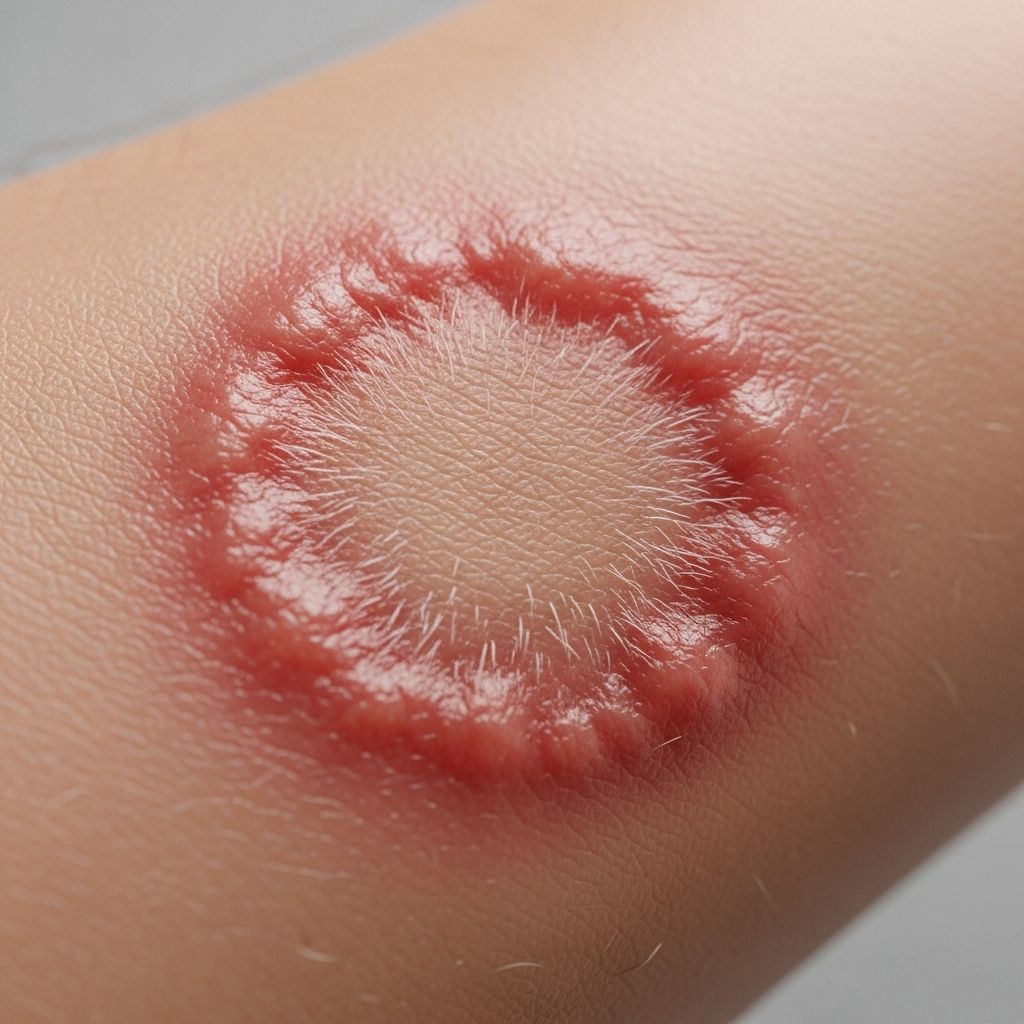Tinea (Ringworm) Infections: Causes, Symptoms, Diagnosis, and Treatment
Comprehensive guide to tinea (ringworm) infections: causes, symptoms, types, diagnosis, treatments, and how to prevent spread.

Tinea, commonly known as ringworm, refers to a group of superficial fungal infections that affect the skin, hair, and nails. Despite the name, ringworm is not caused by a worm but by dermatophyte fungi. These infections are frequent worldwide, affecting people of all ages, and can be both uncomfortable and persistent if not adequately treated. This comprehensive guide explores what tinea infections are, what causes them, the different types, key symptoms, diagnostic approaches, current treatments, risk factors, potential complications, and essential prevention strategies.
What is Tinea (Ringworm)?
Tinea infections are caused by a group of fungi known as dermatophytes, which include species from the genera Trichophyton, Epidermophyton, and Microsporum. These fungi thrive on keratin, a protein found in skin, hair, and nails. The infections manifest as itchy, scaly rashes, often with a characteristic ring-shaped appearance—hence the name “ringworm”.
- Tinea infections can affect nearly any part of the body.
- The classical presentation is a red, annular (ring-shaped) rash with central clearing and a raised, scaly border.
- Ringworm is highly contagious and can spread via skin-to-skin contact, sharing personal items, or exposure to contaminated surfaces.
Main Types of Tinea Infections
Tinea infections are classified based on the affected area of the body:
| Type | Also Known As | Location |
|---|---|---|
| Tinea corporis | Ringworm of the body | Trunk, arms, legs (glabrous, non-hairy skin) |
| Tinea cruris | Jock itch | Groin, inner thighs, buttocks |
| Tinea pedis | Athlete’s foot | Feet, particularly between toes |
| Tinea capitis | Ringworm of the scalp | Scalp and hair shafts |
| Tinea unguium | Onychomycosis | Fingernails, toenails |
| Tinea manuum | Ringworm of the hand | Palms and spaces between fingers |
| Tinea barbae | Barber’s itch | Beard and mustache areas |
| Tinea faciei | Ringworm of the face | Non-bearded facial skin |
What Causes Tinea Infections?
Tinea (ringworm) is caused by dermatophyte fungi that invade and live on the dead keratin of the skin, nails, or hair. Key factors include:
- Dermatophyte species: Most commonly Trichophyton rubrum, Trichophyton mentagrophytes, Microsporum canis, and Epidermophyton floccosum.
- Transmission: Direct skin-to-skin contact or indirect contact via fomites (such as towels, clothing, or combs).
- Animal sources: Pets and livestock (like cats, dogs, cows) can carry and transmit dermatophytes.
- Environmental exposure: Warm, moist environments (e.g., locker rooms, public showers, swimming pools) promote spread.
Who is at Risk?
- Children and adolescents (especially for scalp and body infections)
- Adults (especially for groin and nail infections)
- People living in warm, humid climates
- Individuals with excessive sweating
- Those with weakened immune systems (HIV/AIDS, diabetes, certain medications)
- Athletes, wrestlers, swimmers, and others who have close skin-to-skin contact or share gear
- Pet owners or those regularly in contact with animals
- Persons with poor personal hygiene or those in communal living environments
Most Common Symptoms
Symptoms depend on the specific type and location of the tinea infection, but characteristic features include:
- Itchy, red, circular or oval rash with a raised, scaly, well-defined edge
- Central clearing with a more normal-appearing skin in the center
- Patches or plaques that may expand outward over time
- Possible small blisters or pustules at the periphery
- In some cases (e.g., tinea pedis), scaling, cracking, or peeling skin between toes or on soles
- Thickened, discolored, and brittle nails (tinea unguium)
- Alopecia (patches of hair loss) in scalp infections
How is Tinea Diagnosed?
Diagnosis of tinea is usually straightforward for healthcare professionals and involves:
- Clinical evaluation: Noting the classic ring-like lesions with a scaly, red border.
- Skin scraping and microscopy: Scraping a small amount of scale from the lesion and examining under a microscope after treating with potassium hydroxide (KOH) solution to reveal hyaline, septate, branching fungal hyphae.
- Culture: In uncertain or chronic cases, scaling or nail material may be sent for culture on Sabouraud dextrose agar. Growth may take from several days to up to four weeks.
- Dermoscopy: In some cases, specialized tools can help to visualize fungal elements in hair, scalp, or skin.
- Histopathology: Rarely, a skin biopsy may be performed for difficult-to-diagnose rashes.
How is Tinea Treated?
Topical Antifungal Treatments
- Mild to moderate skin infections can usually be managed with topical creams, lotions, or gels containing:
- Clotrimazole
- Miconazole
- Terbinafine
- Ketoconazole
- Econazole
- Naftifine
- Apply as directed, usually twice daily, for 2 to 4 weeks—even if symptoms resolve sooner.
- Wash hands after applying creams to avoid spreading infection.
Oral Antifungal Treatments
- Extensive, severe, or scalp/nail infections typically require oral (systemic) antifungal medications:
- Terbinafine
- Itraconazole
- Griseofulvin
- Fluconazole
- Courses usually last 4 weeks or longer depending on infection type and response.
Important Treatment Notes
- Topical treatments are ineffective for tinea capitis (scalp) and nail infections.
- Close contacts and pets may need examination and treatment to prevent reinfection.
- Continue using medicines as prescribed even if symptoms quickly clear to ensure eradication of the fungus.
- Over-the-counter antifungal products are effective for many types of skin tinea, but more severe, persistent, or scalp/nail infections require medical prescription therapy.
Complications and When to Seek Medical Care
- Secondary bacterial infection: Broken skin from scratching may allow bacteria to enter, leading to cellulitis or impetigo.
- Chronic or widespread infection: More likely in immunocompromised people.
- Spread to other body sites: Without early treatment, infection can move to groin, feet, or nails.
- Scarring or nail deformity: May occur if infections are severe or untreated for a long time.
Prevention Tips
- Keep skin clean and dry, especially the folds (groin, feet, armpits).
- Avoid sharing clothing, towels, combs, and athletic gear.
- Wear shoes in public showers, gyms, and pools to prevent tinea pedis.
- Launder clothing, bedding, and towels in hot water.
- Clip fingernails and toenails short and clean.
- Wash hands thoroughly after contact with animals and after treating infected skin.
- Treat household pets if they show signs of fungal infection—seek veterinary advice.
- Use antifungal powders or sprays in shoes and socks if prone to athlete’s foot.
Frequently Asked Questions (FAQs)
What is the difference between tinea and ringworm?
There is no difference—”ringworm” is the common name for tinea infections of the skin, nails, or hair caused by dermatophyte fungi, not worms.
Can tinea infections spread between people?
Yes, tinea is highly contagious and may spread via direct contact (skin-to-skin) or indirectly through contaminated objects or surfaces, as well as from pets or livestock.
What is the fastest way to get rid of ringworm?
Proper use of topical or oral antifungal medications is necessary. Quick resolution depends on following prescribed treatment and general hygiene measures. Home remedies alone cannot cure ringworm.
How long do tinea infections last?
With proper treatment, mild skin infections often clear in 2–4 weeks. Nail and scalp infections may take months to resolve due to slower growth rates and deeper fungal involvement.
Can ringworm return?
Yes, reinfection can occur if predisposing factors are not addressed or if contact with an infectious source continues. Treating both the patient and possible sources (people, pets, environments) is essential.
Is tinea dangerous?
Tinea is not usually dangerous but can cause significant discomfort and, without treatment, complications such as secondary infections or widespread skin involvement. Prompt and proper therapy reduces risk.
Key Takeaways
- Tinea (ringworm) is a group of common, contagious fungal skin, nail, and hair infections.
- Classical features include annular, red, scaly lesions that may itch and spread outward.
- Diagnosis is mostly clinical but skin scrapings, microscopy, and cultures can aid in confirmation.
- Effective treatment usually involves topical or oral antifungal medications.
- Prevention relies on hygiene, minimizing skin-to-skin or shared object contact, and treating pets.
References
- Detailed information on tinea corporis and related infections retrieved from the NCBI StatPearls resource and clinical guides.
- Addition clinical and practical guidance drawn from dermatology reference texts and public health advisories.
References
Read full bio of medha deb












